Beaty Biodiversity Museum – 1
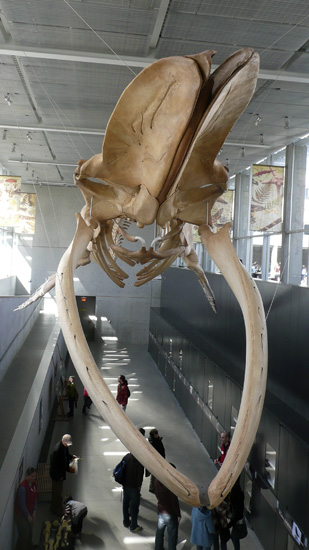
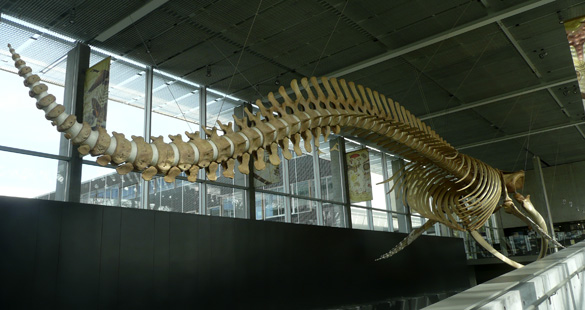
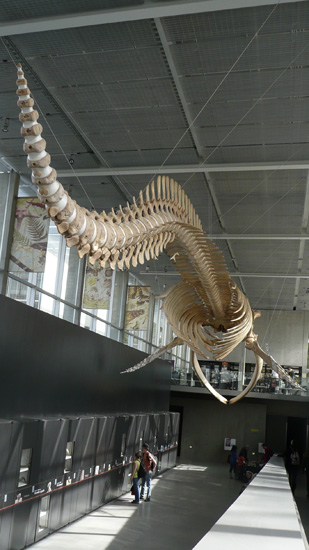
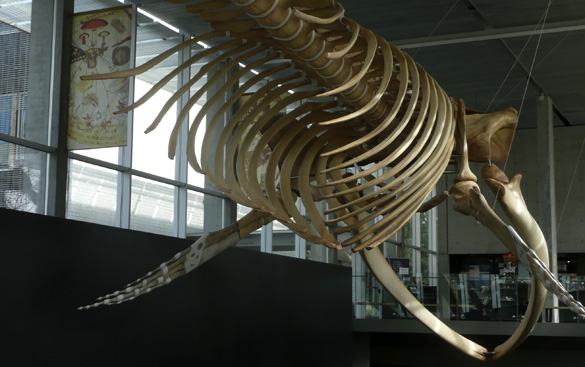
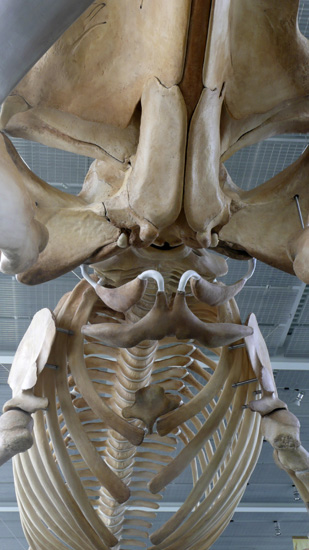
One day last week, we made our first visit to Vancouver’s new Beaty Biodiversity Museum, located on the campus of the University of British Columbia (UBC). A teaching and research facility, the museum is now able to showcase UBC’s natural history collections, with more than two million specimens to the public for the first time.
Among the treasures are a 26-metre-long blue whale skeleton suspended in the two-storey glass Atrium, the second-largest fish collection in the nation, and myriad fossils, shells, insects, fungi, mammals, birds, reptiles, amphibians, and plants from around British Columbia and the world.
The Blue Whale Exhibit is truly magnificent and stunning as the first thing one sees already from the outside and when walking into the atrium. I didn’t, for example, know that:
Blue whales are the biggest animals that have ever lived on earth–longer than the longest known dinosaur, and much more massive.
The Blue Whale story is awe-inspiring:
On the remote northwestern coast of PEI [Prince Edward Island, a small island province in eastern Canada] in 1987, a 26 m long mature female blue whale died and washed ashore near the town of Tignish. In hopes of preserving the whale’s skeleton for research or museum display, the PEI government and the Canadian Museum of Nature arranged for the skeleton to be dragged off the beach near Nail Pond, and buried. The remains of the whale were longer than two Vancouver trolley buses parked one behind the other, and weighed an estimated 80,000 kg. Her burial was a mammoth task.
Because of the difficulty of unearthing and displaying such a large animal, the whale skeleton remained under the red PEI dirt for two decades. In 2007, the Museum of Nature and the PEI government granted UBC permission to retrieve the whale, and bring it to BC to be displayed in the new Beaty Biodiversity Museum.
Moving the skeleton from the coast of PEI to the inside of the Museum’s glass atrium, 6000 km away, [was] a challenging project…
Blue whales are the largest animal ever to have lived on earth. They rarely strand on beaches, and very few skeletons have been recovered for research or display. Worldwide, only 20 are available to the public for viewing.
We learned much from the guide and the posted displays, such as the fact that the whale was killed by a passing ship, how they had to rebuild and put together the huge bones of the skeleton, and that they are on the Red List of Endangered Species. Fortunately the Beaty’s website has excellent videos on the project to learn more, so if you are interested, do check them out at the links. Enjoy!
Continued: Part 2, Part 3, Part 4, Part 5, Part 6 and Part 7.
March 27, 2011 in Canada and BC, Environment, History, Nature, Photoworks by Marja-Leena
Amazing thing, and so beautiful, it looks like it has been carved out of wood.
(Seems funny to speak of the burial of it as ‘a mammoth task’ when a blue whale was so much larger a thing than a mammoth!)
Lucy, I thought it looked like wood too, and actually asked the guide! It is the real thing. Wow, yes, ‘mammoth task’ is indeed funny in this context.
Impressive. I was feeling sad that I didn’t go there when in Vancouver until I found that it was brand new.
Marly, you’ve been to Vancouver – when? Yes, this museum blew my socks off, as I expected it would! I want to go back soon, for there is so much still to see and learn, maybe when the grandkids come visit, they will love it. Oh, and thanks so much for your many visits and lovely comments here, how do you find the time with your own busy writing career and a family?!
Magnificent! This is a place I will have to go to someday. Now I’m thinking of huge sea creatures … the name Lotan sticks in my head, but I can’t place it.
I have given up sleeping. Can be quite helpful.
No, I’ve just decided to blog more and to get out more in the e-space. I tend to feel a bit isolated where I live, at least as a writer.
Hmm, I haven’t been to Vancouver for many decades. In fact, my main memory is of eating in Chinatown! But I had a grand time. I’ll have to dig up my trip journal, which is . . . somewhere. I also went to Victoria, where my most clear memories are of the native American museum…
Rouchswalwe, you would love this place! I keep digging in and reading more and more interesting stuff on their website. I can’t place Lotan either….
Marly, you are talking to an insomniac who doesn’t like to be deprived of her sleep – it is not helpful to me! But I know what you mean, this on-line communication with like minded folks around the world is most enjoyable and addictive and I’m most grateful to have you part of it…. Your trip up here was a long time ago – you’d notice a lot of changes, like one sees in children that have grown up. Come again…
I love the sinuous lines of the skeleton, so clearly designed for swimming.
Yes, it’s pleasant to feel part of a circle.
Might do that… I’ve gotten out more in the past year than in decades–only one kid left in the nest.
Leslee, yes, the scientists did a great job on the articulation of the whale. Just try imagine that kind of work and getting it into the building and up in the air, while making it seem alive in movement! I still feel like my jaw is as wide open from awe as that whale’s (which by the way, was not that open – it would have hit the floor if fully open)!
Marly, looking forward to that day! As for kids leaving the nest, just watch the next phase when they come back… I speak from the voice of experience!
another place to visit to add to my list! I love the photos you took. The story of how the skeleton of the blue whale was collected by the museum is interesting.